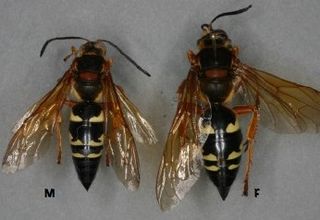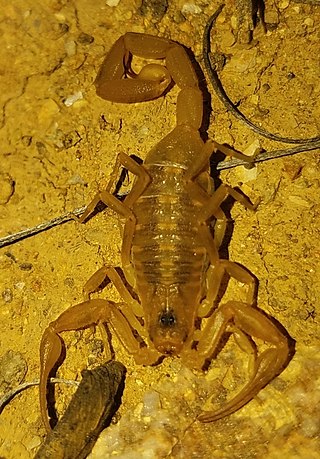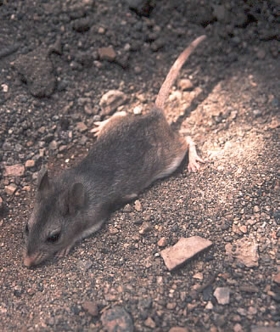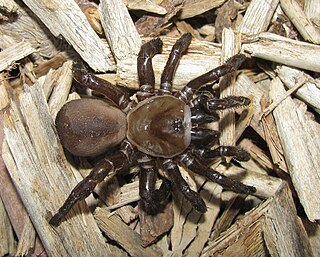
Scorpions are predatory arachnids of the order Scorpiones. They have eight legs and are easily recognized by a pair of grasping pincers and a narrow, segmented tail, often carried in a characteristic forward curve over the back and always ending with a stinger. The evolutionary history of scorpions goes back 435 million years. They mainly live in deserts but have adapted to a wide range of environmental conditions, and can be found on all continents except Antarctica. There are over 2,500 described species, with 22 extant (living) families recognized to date. Their taxonomy is being revised to account for 21st-century genomic studies.

A tarantula hawk is a spider wasp (Pompilidae) that preys on tarantulas. Tarantula hawks belong to any of the many species in the genera Pepsis and Hemipepsis. They are one of the largest parasitoid wasps, using their sting to paralyze their prey before dragging it to a brood nest as living food; a single egg is laid on the prey, hatching to a larva which eats the still-living host. They are found on all continents other than Europe and Antarctica.

A stinger is a sharp organ found in various animals capable of injecting venom, usually by piercing the epidermis of another animal.

Sphecius speciosus, often simply referred to as the cicada killer or the cicada hawk, is a large, solitary digger wasp species in the family Crabronidae. The name may be applied to any species of crabronid that preys on cicadas, though in North America, it is typically applied to this species, also referred to as the eastern cicada killer in order to further differentiate it from the multiple other examples of related wasp species. Sometimes, they are called sand hornets, although they are not hornets, which belong to the family Vespidae. This species can be found in the Eastern and Midwest U.S. and southwards into Mexico and Central America. They are so named because they hunt cicadas and provision their nests with them. Cicada killers exert a measure of natural control on cicada populations, and as such, they may directly benefit the deciduous trees upon which the cicadas feed.

The emperor scorpion, Pandinus imperator, is a species of scorpion native to rainforests and savannas in West Africa. It is one of the largest scorpions in the world and lives for 6–8 years. Its body is black, but like other scorpions it glows pastel green or blue under ultraviolet light. It is a popular species in the pet trade, and is protected by CITES to prevent over-collecting that might affect the species' survival.

The Arizona bark scorpion is a small light brown scorpion common to the Sonoran Desert in the southwestern United States and northwestern Mexico. An adult male can reach 8 cm in length (3.14 inches), while a female is slightly smaller, with a maximum length of 7 cm (2.75 inches).

The elf owl is a small grayish-brown owl about the size of a sparrow found in the Southwestern United States, central Mexico, and the Baja California peninsula. It has pale yellow eyes highlighted by thin white "eyebrows" and a gray bill with a horn-colored tip. The elf owl frequently inhabits woodpecker holes in saguaro cacti; it also nests in natural tree cavities. It is nocturnal and feeds primarily on insects.

Hadrurus arizonensis, the giant desert hairy scorpion, giant hairy scorpion, or Arizona Desert hairy scorpion is a large scorpion found in North America.

Botta's pocket gopher is a pocket gopher native to western North America. It is also known in some areas as valley pocket gopher, particularly in California. Both the specific and common names of this species honor Paul-Émile Botta, a naturalist and archaeologist who collected mammals in California in 1827 and 1828.

Centruroides exilicauda, the Baja California bark scorpion, is a species of bark scorpion found in Baja California. It is closely related to the Arizona bark scorpion, but is not considered dangerous. Previously only distinguished by geographic range, the two variants were classified in 1980 as the same species. Subsequently, differences in venom toxicity were recorded, and in 2004, DNA analysis showed them to be separate species. The Baja California bark scorpion is a slender, long-tailed scorpion, and although it is typically sand-colored it appears in darker colors.

The California vole is a type of vole which lives throughout much of California and part of southwestern Oregon. It is also known as the "California meadow mouse", a misnomer as this species is a vole, not a mouse. It averages 172 mm (6.8 in) in length although this length varies greatly between subspecies.

The southern grasshopper mouse or scorpion mouse is a species of predatory rodent in the family Cricetidae, native to Mexico and the states of Arizona, California, Nevada, New Mexico, and Utah in the United States. Notable for its resistance to venom, it routinely preys on the highly venomous Arizona bark scorpion.

The greater roadrunner is a long-legged bird in the cuckoo family, Cuculidae, from the Aridoamerica region in the Southwestern United States and Mexico. The scientific name means "Californian earth-cuckoo". Along with the lesser roadrunner, it is one of two species in the genus Geococcyx. This roadrunner is also known as the chaparral cock, ground cuckoo, and snake killer.

Many species of arthropods can bite or sting human beings. These bites and stings generally occur as a defense mechanism or during normal arthropod feeding. While most cases cause self-limited irritation, medically relevant complications include envenomation, allergic reactions, and transmission of vector-borne diseases.

Paruroctonus boreus, commonly known as the northern scorpion, is a species of scorpion in the family Vaejovidae. It is the northernmost species of scorpion, the only scorpion found in Canada, and one of the scorpions with the broadest distribution over North America.

Parabuthus granulatus, commonly known as the granulated thick-tailed scorpion, a large species of scorpion from the drier parts of southern Africa. It measures some 11.5 cm, and is dark yellow to brown in colour. It has a relatively small vesicle, but is one of the more venomous scorpion species of the region. Of all scorpion species, it causes most of the serious cases of envenomation in South Africa, and a few people die each year from their sting.

Paruroctonus silvestrii, also known as the California common scorpion and the stripe-tailed scorpion, is a species of scorpion in the family Vaejovidae. This species is native to the coastal region of the Californias. The stripe-tailed scorpion can be found in dry areas, where it creates and dwells in burrows.

Bothriocyrtum californicum, the California trapdoor spider, is a species of spider in the family Halonoproctidae. It is found in the United States. Males are smaller than females. Predators include the spider wasp Psorthaspis planata, which use their bodies as larval nurseries, and skunks, which dig up their burrows.

Hemiscorpius lepturus is a species of scorpion in the family Hemiscorpiidae. It is found in deserts of the Middle East, especially in southern Iraq and Iran, where it is sometimes referred to as the "Gadim scorpion". These scorpions have long, thin tails and wide bodies and grow to 8 cm (3.1 in) in males and 5.5 cm (2.2 in) in females, allowing them to live in tight rock crevices. They are fairly solitary creatures. H. lepturus has mainly been studied to discover the components and effects of its venom, which is highly lethal and is responsible for most deaths due to scorpion sting in the Iran area. H. lepturus is the only scorpion not in the family Buthidae that is potentially lethal to humans; the Buthidae family is the largest and most abundant family of scorpions, containing many highly venomous species.
Lychas buchari, also known as the yellow sand scorpion or Buchar's scorpion, is a species of small scorpion in the Buthidae family. It is native to Australia, and was first described in 1997 by Czech arachnologist Frantisek Kovarik.



















